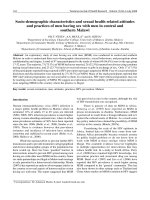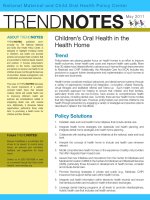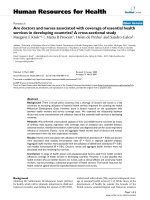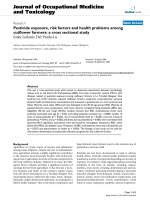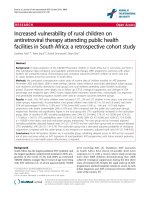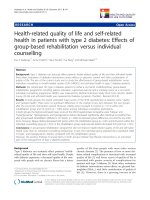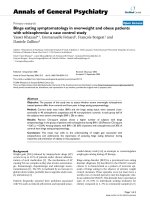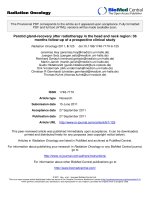Pediatric provider perspectives and practices regarding health policy discussions with families: A mixed methods study
Bạn đang xem bản rút gọn của tài liệu. Xem và tải ngay bản đầy đủ của tài liệu tại đây (1.37 MB, 13 trang )
Vasan et al. BMC Pediatrics
(2020) 20:343
/>
RESEARCH ARTICLE
Open Access
Pediatric provider perspectives and
practices regarding health policy
discussions with families: a mixed methods
study
Aditi Vasan1,2,3*† , Polina Krass1,2,3†, Leah Seifu1, Talia A. Hitt1, Nadir Ijaz1,4, Leonela Villegas1, Kathryn Pallegedara1,
Sindhu Pandurangi1,5, Morgan Congdon1, Beth Rezet1 and Chén C. Kenyon1,3,6
Abstract
Background: Advocacy regarding child health policy is a core tenet of pediatrics. Previous research has
demonstrated that most pediatric providers believe collective advocacy and political involvement are essential
aspects of their profession, but less is known about how pediatric providers engage with families about policy
issues that impact child health. The objectives of this study were to examine providers’ perceptions and practices
with regards to discussing health policy issues with families and to identify provider characteristics associated with
having these discussions.
Methods: In this cross-sectional mixed methods study, pediatric resident physicians, attending physcians, and nurse
practitioners at primary care clinics within a large academic health system were surveyed to assess (1) perceived
importance of, (2) frequency of, and (3) barriers to and facilitators of health policy discussions with families.
Multivariable ordinal regression was used to determine provider characteristics (including demographics, practice
location, and extent of civic engagement) associated with frequency of these discussions. A subset of providers
participated in subsequent focus groups designed to help interpret quantitative findings.
Results: The overall survey response rate was 155/394 (39%). The majority of respondents (76%) felt pediatricians
should talk to families about health policy issues affecting children, but most providers (69%) reported never or
rarely having these discussions. Factors associated with discussing policy issues included being an attending
physician/nurse practitioner (OR 8.22, 95% CI 2.04–33.1) and urban practice setting (OR 3.85, 95% CI 1.03–14.3).
Barriers included feeling uninformed about relevant issues and time constraints. In provider focus groups, four key
themes emerged: (1) providers felt discussing policy issues would help inform and empower families; (2) providers
frequently discussed social service programs, but rarely discussed policies governing these programs; (3) time
(Continued on next page)
* Correspondence:
†
Aditi Vasan and Polina Krass Contributed equally as co-first authors.
1
Department of Pediatrics, Children’s Hospital of Philadelphia, 3400 Civic
Center Boulevard, Philadelphia, PA, USA
2
National Clinician Scholars Program, Perelman School of Medicine,
University of Pennsylvania, Blockley Hall, 13th Floor, 423 Guardian Drive,
Philadelphia, PA 19104, USA
Full list of author information is available at the end of the article
© The Author(s). 2020 Open Access This article is licensed under a Creative Commons Attribution 4.0 International License,
which permits use, sharing, adaptation, distribution and reproduction in any medium or format, as long as you give
appropriate credit to the original author(s) and the source, provide a link to the Creative Commons licence, and indicate if
changes were made. The images or other third party material in this article are included in the article's Creative Commons
licence, unless indicated otherwise in a credit line to the material. If material is not included in the article's Creative Commons
licence and your intended use is not permitted by statutory regulation or exceeds the permitted use, you will need to obtain
permission directly from the copyright holder. To view a copy of this licence, visit />The Creative Commons Public Domain Dedication waiver ( applies to the
data made available in this article, unless otherwise stated in a credit line to the data.
Vasan et al. BMC Pediatrics
(2020) 20:343
Page 2 of 13
(Continued from previous page)
constraints and concerns about partisan bias were a barrier to conversations; and (4) use of support staff and
handouts with information about policy changes could help facilitate more frequent conversations.
Conclusions: Pediatric providers felt it was important to talk to families about child health policy issues, but few
providers reported having such conversations in practice. Primary care practices should consider incorporating
workflow changes that promote family engagement in relevant health policy discussions.
Keywords: Advocacy, Health policy, Political engagement, Primary care
Introduction
Pediatricians have served as child health advocates since
the field’s inception. Abraham Jacobi, one of the founders
of pediatric medicine, famously stated, “every physician is
by destiny a political being.” [1] This responsibility has
been formalized by the American Academy of Pediatrics
(AAP) in their policy statement on Poverty and Child
Health, which recommends that pediatricians “advocate
for public policies that support all children and mitigate
the effects of poverty on child health,“ [2] and by the
Accreditation Council for Graduate Medical Education
(ACGME), which mandates that all pediatric residency
programs provide residents with advocacy training [3].
Previous research has demonstrated that a majority of
physicians believe collective advocacy and political
involvement are important aspects of the medical profession and that most physicians, including pediatricians,
have participated in these activities [4]. In a recent
survey of pediatricians in the United States, the majority
of respondents felt that their professional organization,
the AAP, should engage in advocacy around government
policies impacting child health, including policies related
to income support, housing, education, and access to
health care [5]. These studies show that pediatricians are
motivated to engage in and support advocacy on behalf
of their patients. However, less is known about these
providers’ perceptions and practices in empowering
children and families to advocate directly for themselves
and their own communities.
Recent proposed policy changes have demonstrated
the potential relevance of discussing health policy in a
clinical setting. When funding for the Children’s Health
Insurance Program (CHIP) lapsed in 2017 and early
2018, pediatric providers were encouraged by national
child health organizations, including the AAP, to advocate for the program’s reauthorization [6]. Around the
same time, two editorials written by internal medicine
physicians called upon providers in their field to discuss
policy changes related to health insurance coverage with
their patients more directly [7, 8]. More recently, the
AAP issued a statement emphasizing the potentially
harmful chilling effects of the “public charge” rule in
leading families to disenroll from or avoid applying for
necessary health and social service programs. The AAP
encouraged pediatricians caring for immigrant children
to talk to their patients and families about the “public
charge” rule and to explain to families that many
government benefits, including CHIP and Medicaid for
children under the age of 21, are still not considered in
public charge determination [9].
We developed this study to better understand pediatric
providers’ perspectives and behaviors when it comes to
discussing policy issues like health insurance coverage
and policy changes like the “public charge” rule with
families as part of their clinical practice. Previous literature on this topic is limited to one published study
examining provider perspectives on health policy conversations with patients through a survey administered
to 36 internists [10]. Our study builds on this work both
by specifically assessing pediatric providers’ perspectives
and by utilizing an explanatory sequential mixed
methods design, including an initial quantitative survey
and subsequent focus groups designed to explore and
gain deeper insights into survey responses.
Our aims were to (1) assess pediatric providers’
perspectives and practices in discussing health policy
issues with patients and families, (2) examine provider
characteristics associated with having these discussions,
and (3) identify and understand providers’ perceived
barriers to and facilitators of these discussions.
Methods
Study design and setting
This cross-sectional, explanatory sequential mixed-methods
study of pediatric primary care providers including resident
physicians, attending physicians, and nurse practitioners
was conducted within a large, mid-Atlantic primary care
practice-based research network of 31 primary care practices [11], which includes a pediatric residency program.
This study was approved for exemption by the relevant
Institutional Review Board.
Provider survey
In the first part of this study, an electronic survey was
distributed to all physicians within the pediatric residency program (n = 157) and all primary care providers
within the care network (n = 246) between July 2018 and
September 2018, with two subsequent reminder emails
Vasan et al. BMC Pediatrics
(2020) 20:343
sent to each group. Respondents included resident
physicians (physicians-in-training who practice in both
the primary care and inpatient settings), nurse practitioners (advanced practice nurses who practice primary
care independently), and attending physicians (physicians who have completed training and are responsible
for both practicing primary care independently and
supervising resident physicians). In the survey, child
health policy was defined as “any aspect of local, state,
or federal laws or regulations that may impact children’s
health”, similar to the Centers for Disease Control definition [12].
Quantitative outcomes
The survey was designed to assess two outcomes (1)
providers’ perceptions of the importance of discussing
health policy issues with families, and (2) providers’ selfreported frequency of these conversations. To assess
perceived importance of policy discussions, providers
were asked to rate their agreement with the statement,
“Pediatricians should talk to families about current
health policy issues affecting children,” using a 4-point
Likert scale, where responses of “strongly agree” or
“agree” were then classified as agreeing that these discussions were important.
To assess reported frequency of these conversations,
providers were asked to indicate how frequently they
discussed policy issues with families using a 4-point
scale with options “never,” “rarely,” “sometimes,” and
“always.” To identify provider factors associated with the
practice of discussing policy issues with families, we
operationalized provider frequency of these conversations as an ordinal dependent variable (with categories
“never,” “rarely,” “sometimes,” and “always”) in our
multivariable logistic regression model.
Exposures and covariates
The survey assessed multiple covariates including level
of training, years of experience, demographic characteristics, political affiliation, and civic and political engagement. Civic and political engagement were assessed in
two ways: asking whether providers had voted in the
most recent presidential and midterm elections and asking providers to both evaluate the importance of and report their recent participation in three categories of civic
engagement, as initially described by Gruen et al. [4].
These categories were: collective advocacy (encouraging
medical organizations to advocate for the public’s
health), community participation (providing healthrelated expertise to community organizations), and political involvement (involvement in health policy related
matters at the local, state or federal level), each assessed
using 4-point Likert scales. Providers were categorized
as “civic minded” if they rated the importance of civic
Page 3 of 13
engagement in each of these categories highly and as
“civically engaged” if they reported taking part in any
activity included in collective advocacy, community
participation, or political involvement within the previous three years, consistent with the original study [4].
We hypothesized that providers with more clinical
experience and providers who were more civically and
politically engaged may report talking to families about
health policy issues more frequently.
Providers were asked to select their most significant
barriers to and facilitators of health policy discussions
from a list generated through literature review and piloting of the survey instrument. The barriers listed included
time constraints, discomfort with discussing policy issues,
concerns that policy conversations would be perceived
negatively, and concerns about perceived partisan bias.
The facilitators listed included informational handouts
regarding relevant policy issues and additional support
staff to facilitate policy conversations. In both cases,
providers also had the option to suggest additional
barriers and facilitators not included in the provided list in
the form of open-ended comments. These comments
were subsequently reviewed, and barriers and facilitators
that overlapped with existing categories were reclassified.
Provider focus groups
In the second part of this study, we used our survey
results to inform development of a focus group guide
and then convened focus groups intended to help interpret and elaborate on our survey findings, consistent
with an explanatory sequential mixed-methods approach
with integration through building.
Six 30–45 min provider focus groups were held between
November 2018 and March 2019. All providers who completed the survey were invited to participate, and we held
the focus groups with a convenience sample of providers
who were available at pre-designated times. Three focus
groups included only resident physicians, while the other
three included both attending physicians and nurse practitioners. A discussion guide was used for all focus groups
(Appendix A2), with suggested questions focused on
interpreting our quantitative results and obtaining a more
in-depth understanding of providers’ perceived barriers to
and facilitators of health policy discussions.
Data analysis
Descriptive statistics were used to characterize providers
who responded to the survey. Fisher’s exact tests were
used to determine differences in perceptions and practices
by provider level of training (resident physician versus
attending physician/nurse practitioner). Multivariable
ordinal logistic regression was used to examine variables
associated with providers’ reported frequency of health
policy discussions. Independent variables in this model
Vasan et al. BMC Pediatrics
(2020) 20:343
included demographic characteristics (gender, race/ethnicity, and age), measures of political engagement (party
affiliation, voting history, civic engagement score), and
practice setting. All independent variables were dichotomized with the exception of age. Stratified analyses were
conducted to assess for differences in associations by
trainee status. Survey data was analyzed using STATA
15.1 (College Station, TX).
Focus groups were audio-recorded, transcribed, and
analyzed using QSR International’s NVIVO12 software
(Burlington, MA) using a modified grounded theory
approach [13]. Transcripts were independently reviewed
and coded by two researchers (PK and AV). The study
team iteratively reviewed codes, identified emerging
themes, and resolved any discrepancies through consensus. Initial codes used to generate these themes included
perceived importance of policy discussions, frequency of
policy discussions, barriers to discussing policy, and
facilitators of policy discussions. Although resident physician and attending physician/nurse practitioner focus
groups were held separately, all focus group discussions
were grouped together in this qualitative analysis
because similar themes emerged from the two subsets of
providers.
Page 4 of 13
Table 1 Characteristics of Study Participants
Characteristics
Gender
Overall, the majority of survey respondents (78%) agreed
that pediatricians should talk to families about health
37 (24%)
Female
119 (76%)
Resident Physician
91 (58%)
Attending Physician
55 (35%)
Nurse Practitioner
11 (7%)
Race/Ethnicity
White
122 (78%)
Asian
16 (10%)
Hispanic
12 (8%)
African-American
6 (4%)
Practice Setting
Urban
120 (76%)
Suburban
37 (24%)
Political affiliation
Democrat
Participant characteristics
Importance of health policy discussions
Male
Level of Training
Results
A total of 157 providers completed the survey, for an
overall response rate of 39%. The response rate was 58%
for resident physicians and 27% for attending physicians/nurse practitioners. Table 1 displays participant
characteristics. Most respondents were female (76%) and
identified as White (78%). The median age of respondents was 30 years. Seventy-six percent of providers
(including all residents) practiced at one of three urban
primary care practices, with the remainder practicing at
suburban primary care sites. The majority of participants
(75%) reported Democratic party affiliation.
Nearly all participants (96%) reported voting in the
most recent presidential election, and 65% reported
voting in the most recent midterm election. A significantly greater proportion of attending physicians/nurse
practitioners reported voting in the most recent midterm
election, as compared to resident physicians (82% vs.
61%, p < 0.001). Almost all providers (91%) were classified as “civic minded” and 98 providers (62%) were
“civically engaged”.
A total of 28 providers, including 14 attending physicians, 11 residents, and 3 nurse practitioners participated
in one of our six focus groups.
Number of
participants (%)
(n = 157)
117 (75%)
Republican
7 (4%)
Independent
13 (8%)
Other/Prefer not to say
20 (13%)
Voting history
Last midterm election
102 (65%)
Last presidential election
151 (96%)
Both elections
102 (65%)
Public participation
Civic mindeda
143 (91%)
Local community involvement
111 (71%)
Local, state or federal political involvement
100 (64%)
Organizational advocacy
129 (82%)
b
98 (62%)
Local community involvement
50 (32%)
Local, state or federal political involvement
67 (43%)
Organizational advocacy
46 (29%)
Civically engaged
a
Participants were defined as civic minded if the sum of scores of community
participation, political involvement, and collective advocacy (range from 3 to
12) were greater than 10
b
Participants were defined as civically engaged if they answered “yes” to
taking part in any activity in community participation, political involvement, or
collective advocacy in the past 3 years
policy issues affecting children, including 86% of resident
physicians as compared to 66% of attending physicians/
nurse practitioners (Fig. 1, p = 0.001).
In focus groups, participants similarly agreed that it
was important for pediatricians to discuss health policy
Vasan et al. BMC Pediatrics
(2020) 20:343
Page 5 of 13
Fig. 1 Provider Beliefs Regarding Health Policy Discussions with Families. Difference between resident physicians and attending physicians or
nurse practitioners is statistically significant (p = 0.001)
issues with families (Table 2). Several providers felt that
discussing relevant health policy issues was an important way for them to inform and empower their
patients and families. One provider said, “I think we
should be involved in helping to empower families to
make their voices heard…the kids themselves don’t
have a voice, you know, it’s us as their providers,
keeping in mind their best interest, and their parents”
(Resident Physician B).
Frequency of health policy discussions
Although the majority of providers felt health policy
discussions with families were important, few reported
having these discussions in practice, with 69% of
providers reporting never or rarely discussing policy
issues. A significantly greater proportion of resident physicians (80%) as compared to attending physicians/nurse
practitioners (54%) reported never or rarely having these
conversations (Fig. 2, p < 0.001).
Table 2 Importance and frequency of policy discussions: representative quotations and major themes elicited from focus group
analysis
Themes
Representative Quotations
Perceived importance
of policy discussions
Discussing relevant policy issues allows
providers to inform and empower families
“Anything you can do to lend your voice, and particularly empower
your patients to lend their voices to these issues is really
important.” – Attending Physician A
“If [patient] testimony is what’s necessary to change
things…[providers] should be in a position to educate people and
get them involved, since we’re their contact with the healthcare
system.” – Resident Physician A
“I think we should be involved in helping to empower families to
make their voices heard… the kids themselves don’t have a voice,
you know, it’s us as their providers, keeping in mind their best
interest, and their parents.” – Resident Physician B
Current frequency of
policy discussions
Clinicians more frequently discuss timely
issues or issues that are directly related to
provision of medical care
“I think it was useful around the time of the election … when we
were also trying to register families [to vote], to use that as a current
event that could help you talk about policy issues.” – Resident
Physician C
“If there’s something that’s immediately related to something
[families] bring up or that you elicit in the interview, then I think that
could be really an effective time to talk about this. “
– Resident Physician D
Clinicians frequently discuss social service
programs with families, but do not often
discuss the policies governing these
programs
“When I talk to my families, I’m not talking broad policy things, I’m
more assessing their situation - Are the kids in preschool or Head
Start?… Do they have food insecurity?”
– Attending Physician B
“I probably feel a little more comfortable talking about … resources,
and to make sure that they’re aware of what resources they’re eligible
for and if not, how to get them.” – Resident Physician E
Vasan et al. BMC Pediatrics
(2020) 20:343
Page 6 of 13
Fig. 2 Providers’ Self-Reported Frequency of Health Policy Discussions with Families. No participants selected “always.” Difference between
resident physicians and attending physicians or nurse practitioners is statistically significant (p < 0.001)
In focus groups, some providers described more
frequently discussing policy issues that seemed directly relevant to a patient’s current medical problems
(Table 2). One provider said, “If there’s something that’s
immediately related to something [families] bring up or
that you elicit in the interview, then I think that could be
really an effective time to talk about this” (Resident Physician D). Other providers said they frequently discussed
individual social services such as nutrition and education
programs with patients, but did not usually frame these as
broader policy issues. “One of the things I find a natural
way to bring up is nutrition programs [like] WIC [and]
SNAP...I don’t normally get to the next step of ‘you should
support those things’ or ‘you should think about your
elected officials and whether they support those things’”
(Attending Physician E).
In our multivariable regression (Table 3), factors
associated with increased frequency of health policy discussions included being an attending physician or nurse
practitioner, as compared to being a resident physician
(OR 8.2, 95% CI 2.0–33.1) and practicing in an urban
setting as compared to a suburban setting (OR 3.8, 95%
CI 1.0–14.3). In analyses stratified by provider type (resident versus attending/nurse practitioner), voting in the
previous midterm election was associated with increased
odds of having health policy discussions for resident
Table 3 Multivariable Model Results Assessing Associations between Provider Characteristics and Frequency of Health Policy
Discussions with Families.*
OR (95% CI)
All providers
Residents
Attending Physicians and
Nurse Practitioners
Provider experience*
8.22 (2.04–33.1)a
–
–
Gender
0.61 (0.27–1.38)
0.48 (0.19–1.24)
2.36 (0.40–13.7)
Non-white race /ethnicity
1.95 (0.67–5.65)
1.32 (0.38–4.61)
4.97 (0.39–63.5)
Age (y)
1.02 (0.96–1.08)
0.91 (0.71–1.15)
1.06 (0.98–1.15)
Democatic party affiliation
1.68 (0.72–3.95)
2.47 (0.82–7.41)
0.6 (0.12–2.95)
0.93 (0.03–30.0)
9.22 (1.72–49.2)d
Urban practice setting
3.85 (1.03–14.3)
b
c
Voting history**
1.78 (0.82–3.84)
2.79 (1.10–7.08)
0.29 (0.04–2.25)
Civic minded
1.68 (0.45–6.29)
1.54 (0.13–18.9)
0.89 (0.14–5.6)
Civically engaged
1.57 (0.77–3.21)
1.23 (0.52–2.9)
2.84 (0.66–12.1)
All independent variables are dichotomized apart from age
*Defined as being an Attending Physician or Nurse Practitioner, as compared to a Resident. **Defined as a history of voting in both the most recent midterm and
most resident presidential election.
a
p = 0.003
b
p = 0.044
c
p = 0.031
d
p = 0.009
Vasan et al. BMC Pediatrics
(2020) 20:343
physicians (OR 2.8, 95% CI 1.1–7.1), and urban practice
setting was associated with increased odds of having
these discussions for attending physicians/nurse practitioners (OR 9.2, 95% CI 1.7–49.2).
Barriers to health policy discussions
Survey participants identified several key barriers to
health policy discussions, including time constraints
Page 7 of 13
(79% of respondents), lack of knowledge about policy
issues (57%), concerns about negative family perception
(48%), and provider discomfort with discussing policy
issues (43%) (Fig. 3A). Participants reported a total of 15
unique barriers to policy discussions in the survey.
In focus groups, the most salient barriers to health
policy discussions identified by participants were time
constraints, concerns about family perception, and
Fig. 3 a Barriers to Health Policy Discussions: Quantitative and Qualitative Results. Time constraints were the most commonly reported barrier to
having health policy discussions in quantitative analysis and represented a salient barrier in qualitative analysis. b Facilitators of Health Policy
Discussions: Quantitative and Qualitative Results. Standardized information about policy issues and workflow changes involving support staff were
frequently discussed facilitators for having health policy discussions in quantitative analysis and were commonly discussed and emphasized in
quantitative analysis
Vasan et al. BMC Pediatrics
(2020) 20:343
concerns about perceived partisan bias. Several participants worried that patients’ families may perceive discussions about health policy in the clinical setting
negatively. One physician stated, “I don’t talk about
[health policy] because…it’s hard to talk about without
making it political” (Attending Physician C). Focus
group participants also raised concerns about how race,
class, and power differentials between providers and
patients might complicate these discussions. One provider said, “I’m afraid a patient’s going to turn to me and
say, “Well, I saw you drive in [to clinic] in a Volvo, and
you don’t understand my life.” And that’s probably true.
So I’m very sensitive to that” (Attending Physician E).
Facilitators of health policy discussions
In our survey, providers identified informational handouts (71% of respondents), electronic health recordbased templates with health policy information (61%),
and involvement of support staff (58%) as interventions
that could help facilitate more frequent policy discussions (Fig. 3B). Survey participants reported a total of 10
unique facilitators of policy discussions.
Focus group participants similarly felt that information
about policy issues available to providers and families,
including written materials explaining relevant health
policy issues and talking points that could be used when
discussing these issues, could facilitate discussions. One
provider remarked, “It could be another folder in the office…so if you want, and the moment is right to have
that conversation, the barrier doesn’t have to be that you
don’t have access to information” (Resident Physician F).
Participants also recommended utilizing support staff,
such as social workers or volunteers from community
organizations focused on political engagement, to hold
these discussions with families. As one participant
explained, “Those concepts [of using support staff]
make me think of a medical home… those ancillary
services are important and [we should be] trying to
find ways to integrate them…so that [families] feel
like the clinic is a safe space where they can go for
multiple reasons” (Resident Physician D).
Discussion
To our knowledge, this study is the first investigation of
pediatric provider perspectives and practices in discussing health policy topics with patients and families. We
found a substantial disconnect between provider beliefs
regarding the importance of these conversations and the
frequency with which they reported having these discussions in practice. Factors associated with discussing
health policy issues more frequently included increased
provider experience and practicing in an urban setting.
In our sample, 78% of providers agreed that pediatricians should talk to patients about health policy issues,
Page 8 of 13
yet 69% reported never or rarely having these conversations in practice. These results are similar to those of
the one prior survey examining policy discussions
among internal medicine physicians, in which 83% of
respondents felt it was appropriate to remind patients to
vote and 42% felt it was appropriate to discuss politically
oriented health care issues in clinic, but only 42% reported initiating a discussion about voting and only 17%
reported initiating a discussion about another politically
oriented health care issue in their clinical practice [10].
This discordance between providers’ perceptions of the
importance of policy discussions and their self-reported frequency of discussing policy issues is consistent with a larger
body of behavioral research. There are several behavioral
models that have been used to predict volitional action, including the Theory of Planned Behavior [14, 15], which has
been used to explain discrepancies between physicians’
ideal behavior and reported action in a wide range of settings, including adherence to clinical guidelines [16–19]
and counseling on specific topics [20, 21]. In these cases,
differences between perception and practice are influenced
by physician intention, social normalization, and physicians’
perceived ability to perform the action. This model suggests
that even if physicians believe a new intervention or approach is important, they will be unlikely to adopt it unless
they believe it is both feasible and accepted among their
peers.
Our observed disconnect between perceptions and
practices was more prominent for resident physicians,
with 86% agreeing that pediatricians should discuss
policy issues, but 80% reporting never or rarely having
these discussions. This finding was consistent with our
multivariable model findings, which demonstrated that
attending physicians and nurse practitioners had increased odds of having policy discussions as compared
to resident physicians. These results could be partly
explained by the barriers elucidated by respondents in
our survey and focus groups. Resident physicians may
face more significant time constraints than their nontrainee colleagues due to their relative inefficiency. They
may also be less likely to have longitudinal relationships
with families that could build trust and provide a basis
for potentially sensitive discussions.
We hypothesized that civic engagement and civic
mindedness may have been associated with increased
rates of health policy discussions but found no association between these characteristics and frequency of
policy discussions in our multivariable model. This may
have been partially because the majority of our respondents, both residents and attendings, were classified as
both civic minded and civically engaged. There may
also have been collinearity between these measures and
other independent variables included in the analysis,
such as voting history or political affiliation.
Vasan et al. BMC Pediatrics
(2020) 20:343
Our multivariable regression showed an association
between urban practice setting and increased frequency
of policy discussions. Providers at these urban practices
serve a predominantly low-income, Medicaid insured
population and therefore may have perceived policy
issues related to government programs and benefits as
more directly relevant to their patient population. Providers choosing to practice in these settings may also
place a higher priority on understanding and influencing
the impact of health policies on their patients’ health.
Our findings suggest that pediatric practices should
consider workflow changes that promote a broader
framework of child and family engagement in important
health policy discussions in the clinic. Several providers
in our study expressed a desire to have resources
supporting health policy discussions integrated into
clinic visits, for example, through informational handouts available to families in the waiting room or offered
to families by clinic support staff. Interventions such as
these may also empower patients to initiate discussions
about health policy with their providers, which may
mitigate providers’ concerns about patients perceiving
these conversations negatively. Clinics could also partner
with community-based organizations focused on
promoting political engagement to hold co-located voter
registration drives or informational sessions about relevant policy issues, allowing families to obtain this information before or after bringing their children to clinic
visits without taking up valuable time during a clinical
encounter. Our findings suggest that incorporating these
interventions in resident primary care clinics may be
particularly beneficial.
There are a number of limitations to our study. Our
overall survey response rate of 39% was relatively low,
although comparable to prior published studies of survey
research involving pediatricians, which reported response rates ranging from 29 to 46% [22–24]. Variable
response rates to our questionnaire may have skewed
the sample if participants who viewed health policy discussions more favorably were more likely to respond.
Further, a majority of respondents identified as civically
engaged, potentially making them more likely to support
policy discussions than physicians who were less civically
engaged. Despite this, few respondents reported routinely having these conversations in practice, suggesting
that our findings may represent a conservative estimate.
Our data was gathered from a single network of
academic primary care clinics, with an associated office
of government affairs and a relatively low-income, highneed patient population, particularly at the urban clinic
sites. In addition, the residents in this sample all trained
in a program with a robust longitudinal advocacy
curriculum. It may therefore be difficult to generalize
our results to other practice settings. While we
Page 9 of 13
attempted to define the term “health policy” specifically
in our questionnaire and focus groups, it is possible that
providers interpreted this term more broadly as any
conversation with families about government benefits
programs for which they may be eligible, which may
have increased the number of participants identifying
these conversations as important or reporting having
these conversations in practice.
Additionally, we used single survey items, rather than
validated survey instruments, to measure our primary
outcome variables of interest, perceived importance of
screening and self-reported frequency of screening. To
our knowledge, there are no existing validated instruments or composite scores to assess these constructs.
Future surveys focused on patient-provider conversations about health policy issues may help to validate
both our selected survey questions and our findings.
Our focus groups represent a convenience sample of
providers who were available during pre-selected focus
group times, rather than with a purposefully selected
subset of providers. This may have resulted in selection
bias and may have made our focus group sample less
representative of the overall sample of providers who
completed the survey.
Lastly, and importantly, while this study investigates
provider attitudes and practices, it does not include
patient or family perspectives on having health policy
discussions in clinical settings. Additional research
should explore family perspectives in order to create and
implement interventions aimed at facilitating these discussions in ways that are efficient, meaningful, relevant,
and acceptable to families.
Conclusion
We found that the majority of pediatric primary care
providers in our sample believed it was important to
talk to families about health policy issues impacting
children. However, few providers reported having
these conversations in practice, with provider experience and practice in an urban setting associated with
an increased frequency of policy discussions. There
may be an opportunity for pediatric primary care
practices to partner with community-based organizations to empower patients and families and create
targeted informational materials focused on health
policy issues that could facilitate these important
conversations.
Appendix
Survey Questionnaire
In this survey, we are assessing [1] provider attitudes towards talking to families about policy issues relevant to
children’s health and [2] provider attitudes toward advocating on their patients’ behalf.
Vasan et al. BMC Pediatrics
(2020) 20:343
In this survey, “policy issue” refers to an aspect of
local, state, or federal laws or regulations that may
impact children’s health. For example, a discussion of
“gun-related policy” may involve the current gunrelated laws and regulations, any proposed changes to
these laws and regulations, and how an individual
may become involved in advocacy related to these
laws and regulations (by voting, rallying, petitioning,
etc.). This is in contrast to family-specific screening
(e.g. for food insecurity or poverty) and patientspecific anticipatory guidance (e.g. counseling about
gun safety).
Please answer honestly. Your survey answers will be
completely anonymous. This survey should take 5–10
min to complete.
Part 1: Discussing policy issues with families.
1. Do you believe that pediatricians should encourage parents and age-eligible patients to vote?
– Yes
– No
– Unsure
2. Do you think believe that pediatricians should
provide families with information about how to
contact their local/state/federal representatives?
– Yes
– No
– Unsure
3. Please rate your agreement with the following
statement: “I believe that pediatricians should talk to
families about current health policy issues affecting
children”
(4 options: Strongly Disagree, Disagree, Agree, Strongly
Agree)
3a. For each of the specific policy issues below,
please rate your agreement with the following statement: “I believe that pediatricians should talk to families about _________”:
(4 options for each: Strongly Disagree, Disagree, Agree,
Strongly Agree)
- Immigration policy.
- Gun-related policy.
- Health insurance coverage and access to care.
- Price and access to medications.
- LGBTQ/Transgender health policy (including policies surrounding access to care and policies relating to
discrimination).
- Parental leave / childcare-related policy.
- Policies related to food assistance programs
(SNAP, WIC, etc.)
Page 10 of 13
- Policies related to early childhood education (Early
Intervention, Head Start, Universal Pre-K, etc.)
- Policies related to education for school-aged children
(eg. charter schools).
- Vaccination-related policy.
4. How often do you currently talk to families
about health policy issues affecting children?
(4 options: Never (0–25% of the time)/Rarely (25–50%
of the time)/Sometimes (50–75% of the time)/Always
(More than 75% of the time))
4a. How often do you currently talk to families
about the following issues?
(4 options: Never (0–25% of the time)/Rarely (25–50%
of the time)/Sometimes (50–75% of the time)/Always
(More than 75% of the time))
- Immigration policy.
- Gun-related policy.
- Health insurance coverage and access to care.
- Price and access to medications.
- LGBTQ/Transgender health policy (including policies surrounding access to care and policies relating to
discrimination).
- Parental leave / childcare-related policy.
- Policies related to food assistance programs (SNAP,
WIC, etc.)
- Policies related to early childhood education (Early
Intervention, Head Start, Universal Pre-K, etc.)
- Policies related to education for school-aged children
(eg. charter schools).
- Vaccination-related policy.
5. What do you consider the major barriers to talking
to families about these issues? (Select all that apply)
– I don’t think we should talk to families about health
policy issues
– I don’t have time to talk to families about these
issues
– I don’t feel comfortable talking to families about
these issues
– I worry that families will perceive conversations
about health policy negatively
– I worry that my institution / organization will not
approve of me discussing policy with patients
– I worry that these conversations will not be
beneficial to patients and families
– I don’t have enough information about these issues
– Other: _____________
6. What do you think would help overcome these
barriers? (check all that apply)
– Informational handouts regarding relevant political
issues
– Templates in the electronic medical record related
to relevant political issues
Vasan et al. BMC Pediatrics
(2020) 20:343
– Survey showing a patient/family’s level of interest in
political information
– Having another member of the care team (SW,
medical student, volunteer from an external
organization) available to talk to interested families
about relevant policy issues
– I don’t think it is appropriate to talk about these
issues
– I don’t think my institution / organization will allow
me to talk about these issues / give out this
information
– Other: ______________
7. What suggestions do you have about how we can
more effectively talk to families about relevant health
policy issues?
(Free text)
Part 2: Physician public roles and advocacy.
8. How important is it for physicians to provide healthrelated expertise to local community-organizations (eg.
School boards, parent-teacher organizations, athletic
teams, and local media)?
(4 options: Not at all important/Not very important/
Somewhat important/Very important)
9. In the past 3 years, have you provided healthrelated expertise to local community organizations?
- Yes.
- No.
10. How important is it for physicians to be politically involved (other than voting) in health-related
matters at the local, state, or national level?
(4 options: Not at all important/Not very important/
Somewhat important/Very important)
11. In the past 3 years, have you been politically active (other than voting) on a local health care issue?
- Yes.
- No.
12. How important is it for physicians to encourage
medical organizations to advocate for the public’s
health?
(4 options: Not at all important/Not very important/
Somewhat important/Very important)
13. In the past 3 years, have you encouraged your
professional society to address a public health or policy issue that is not primarily concerned with physician welfare?
- Yes.
- No.
Part 3: Provider characteristics.
14. What is your current provider role?
– Resident Physician
– Attending Physician
– Nurse Practitioner
Page 11 of 13
15. How many years have you been in practice since
graduating from your medical school / nurse practitioner program?
- < 5 years.
- 5-15 years.
- > 15 years.
16. What is your main location of primary care
practice?
17. What is your gender?
- Male.
- Female.
- Other (free text):
18. What is your ethnicity?
- White / Caucasian.
- Black / African American.
- Hispanic.
- Asian or Pacific Islander.
- American Indian or Alaskan Native.
- Other (free text).
19. What is your age?
(Free text)
20. What is your political affiliation?
–
–
–
–
–
–
–
Democrat
Republican
Libertarian
Green
Independent
Other: _________
Prefer not to say
21. Did you vote in the most recent presidential
election (2016)?
– Yes
– No
– Prefer not to say
22. Did you vote in the most recent congressional
midterm election (2014)?
– Yes
– No
– Prefer not to say
Focus Group Guide
At the start of each focus group, we shared a written
summary of our key survey findings with all participants.
We then facilitated the focus groups using the suggested
questions below:
Interpreting Survey Results.
1. What do you think about these results? What do
you find most interesting? What do you find most
surprising?
Vasan et al. BMC Pediatrics
(2020) 20:343
Importance of Advocacy and Policy Discussions.
2. Do you think it is important for pediatricians to
advocate on behalf of their patients? Why or why not?
3. Which health policy issues do you think are most
important for pediatricians to bring up with their
patients? Why do you think these issues are important?
Barriers to and Facilitators of Policy Discussions.
4. What do you think are the major barriers to talking
to patients and families about health policy issues?
5. What do you think we could do to help providers
more effectively talk to families about relevant health
policy issues?
6. When it comes to talking to families about health
policy issues, who do you think should be leading these
discussions? (Eg. Physicians, nurses, social workers,
medical assistants, etc.)
7. Is there anything else you would like to share with
our team?
Abbreviations
AAP: American Academy of Pediatrics; ACGME: Accreditation Council for
Graduate Medical Education; CHIP: Children’s Health Insurance Program;
SNAP: Supplemental Nutrition Assistance Program; WIC: Special
Supplemental Nutrition Program for Women, Infants, and Children
Acknowledgements
Not applicable.
Authors’ contributions
PK and AV conceptualized and designed the study, designed the data
collection instrument, coordinated and supervised data collection, carried
out the data analysis, and drafted the initial manuscript. LS, TH, and SP
helped to conceptualize and design the study, helped design the data
collection instrument, assisted with data collection, and reviewed and
revised the manuscript. NI, LV, KP, and MC helped to conceptualize and
design the study, assisted with data collection, and reviewed and revised the
manuscript. BR contributed to conceptualizing and designing the study and
critically reviewed and revised the manuscript. CK supervised
conceptualization and design of the study, assisted in the data analyses, and
critically reviewed and revised the manuscript. The author(s) read and
approved the manuscript.
Funding
All phases of this study were supported by an American Academy of
Pediatrics Resident Community Access to Child Health (CATCH) grant. Dr.
Kenyon’s time on this project was supported by a K-award from the NHLBI
(5K23HL136842–02). The AAP and the NHLBI were not directly involved in
study design, collection, analysis, and interpretation of the data, writing of
the manuscript, or the decision to submit the article for publication.
Availability of data and materials
The datasets used and/or analyzed during the current study are available
from the corresponding author on reasonable request.
Ethics approval and consent to participate
This study was approved for exemption by the Children’s Hospital of
Philadelphia Institutional Review Board. Participants in the survey portion of
this study indicated their consent participate as part of the electronic survey.
Focus group participants gave verbal consent to participate in the study at
the start of each focus group.
Consent for publication
Not applicable.
Competing interests
The authors declare that they have no competing interests.
Page 12 of 13
Author details
1
Department of Pediatrics, Children’s Hospital of Philadelphia, 3400 Civic
Center Boulevard, Philadelphia, PA, USA. 2National Clinician Scholars Program,
Perelman School of Medicine, University of Pennsylvania, Blockley Hall, 13th
Floor, 423 Guardian Drive, Philadelphia, PA 19104, USA. 3PolicyLab, Children’s
Hospital of Philadelphia, 2716 South St. Roberts Center for Pediatric Research,
10th Floor, Philadelphia, PA, USA. 4Department of Pediatrics, Division of
Critical Care Medicine, Columbia University, 630 West 168th Street, New York,
NY, USA. 5Cincinnati Children’s Hospital Medical Center, Division of
Gastroenterology, 3333 Burnet Ave, Cincinnati, OH, USA. 6Perelman School of
Medicine, University of Pennsylvania, 3400 Civic Center Boulevard,
Philadelphia, PA, USA.
Received: 30 March 2020 Accepted: 2 July 2020
References
1. Paulson JA. Pediatric advocacy. Pediatr Clin N Am. 2001;48(5):1307–18.
/>2. AAP Council on Community Pediatrics. Poverty and child health in the
United States. Pediatrics. 2016;137(4):e20160339. />peds.2016-0339.
3. Accreditation Council for Graduate Medical Education. Program
Requirements for Graduate Medical Education in Pediatrics.; 2007. http://
www.acgme.org/acWebsite/downloads/RRC_progReq/320_pediatrics_
07012007.pdf.
4. Gruen RL, Campbell EG, Blumenthal D. Public roles of US physicians. Jama.
2006;296(20):2467. />5. Federico SG, Cull W, Olson L, et al. United States pediatricians’ attitudes
regarding public policies for low-income children and their Profession’s
advocacy priorities. Acad Pediatr. 2018;18(7):783–8. />acap.2018.04.003.
6. Children’ s Health Insurance Program (CHIP) Advocacy Toolkit.
7. Avorn J. Engaging with patients on health policy changes. JAMA. 2018;
319(3):233. />8. Ofri D. Doctors should tell their patients to vote. October: The New York
Times; 2018.
9. Goza S. AAP Statement Responding to Supreme Court Ruling on Public
Charge. n-us/about-the-aap/aap-press-room/Pages/
AAPStatementSupremeCourtRulingonPublicCharge.aspx. .
10. Umscheid C, Lee B, Gross R, Turner B. Do physicians discuss political issues
with their patients? J Gen Intern Med. 2006;21(4):400–1.
11. Fiks AG, Grundmeier RW, Margolis B, et al. Comparative effectiveness
research using the electronic medical record: an emerging area of
investigation in pediatric primary care. J Pediatr. 2012;160(5):719–24. https://
doi.org/10.1016/j.jpeds.2012.01.039.
12. Oxford University Press. Definition of policy. Oxford Dictionaries. 2011:
248826.
13. Charmaz K. Constructing Grounded Theory. 2nd ed. SAGE; 2014.
14. Grimshaw JM, Eccles MP, Walker AE, Thomas RE. Changing physicians’
behavior: what works and thoughts on getting more things to work. J
Contin Educ Heal Prof. 2002;22(4):237–43. />1340220408.
15. Perkins M, Oettingen G, Hoagwood K, et al. Applying Theory-driven
approaches to understanding and modifying clinicians’ behavior: what do
we know? Psychiatr Serv. 2007;58(3):342–8.
16. Walker AE, Grimshaw JM, Armstrong EM. Salient beliefs and intentions to
prescribe antibiotics for patients with a sore throat. Br J Health Psychol.
2001;6(4):347–60. />17. Pathman DE, Konrad TR, Freed GL, Freeman VA, Koch GG. The awareness-toadherence model of the steps to clinical guideline compliance: the case of
pediatric vaccine recommendations. Med Care. 1996;34(9):873–89. https://
doi.org/10.1097/00005650-199609000-00002.
18. Cabana MD, Rand CS, Powe NR, et al. Why don’t physicians follow clinical
practice guidelines?: a framework for improvement. J Am Med Assoc. 1999;
282(15):1458–65. />19. Ajzen I. The theory of planned behavior. Organ Behav Hum Decis Process.
1991. />20. Millstein SG. Utility of the theories of reasoned action and planned behavior
for predicting physician behavior: a prospective analysis. Health Psychol.
1996;15(5):398–402. />
Vasan et al. BMC Pediatrics
(2020) 20:343
21. Samuels EA, Dwyer K, Mello MJ, Baird J, Kellogg AR, Bernstein E. Emergency
department-based opioid harm reduction: moving physicians from willing
to doing. Acad Emerg Med. 2016;23(4):455–65. />acem.12910.
22. Garg A, Cull W, Olson L, et al. Screening and referral for low-income
families’ social determinants of health by US pediatricians. Acad Pediatr.
2019;000:1–9. />23. Desposito F, Lloyd-Puryear MA, Tonniges TF, Rhein F, Mann M. Survey of
pediatrician practices in retrieving statewide authorized newborn screening
results. Pediatrics. 2001. />24. Henry-Reid LM, O’Connor KG, Klein JD, Cooper E, Flynn P, Futterman DC.
Current pediatrician practices in identifying high-risk behaviors of
adolescents. Pediatrics. 2010. />
Publisher’s Note
Springer Nature remains neutral with regard to jurisdictional claims in
published maps and institutional affiliations.
Page 13 of 13
